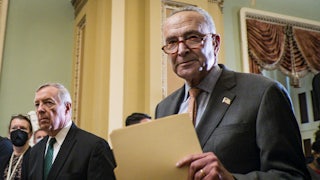For a political press hopelessly addicted to speculation about the next big election, there are precious few data points to obsess over during the first year of a president’s term. New York City elects a mayor during this off-off-year, but it’s an election that’s typically too chaotic and too particular to really tell us much of anything about national trends. New Jersey elects a governor, but the Garden State has become so reliably blue that it hardly registers as a point of interest: Its days of electing gruff Republicans seem to be long gone. And so it must be periwinkle-hued Virginia and its gubernatorial election that serves as the all-important political bellwether upon which pundits and analysts project their notions.
CNN has noted that, should Democrat and one-time Virginia Governor Terry McAuliffe lose to Republican Glen Youngkin, “Democrats would tip into full-on panic about next year’s midterms.” And while it was only two years ago that The New York Times marveled at Virginia’s rapid shift from red to “solid blue,” the paper of record is now warning of an enthusiasm gap that could spell trouble for Democrats in 2022: Without Donald Trump to kick around, McAuliffe was “straining to motivate the liberal voters in his increasingly blue state.”
Given the tight polls, Democrats have been white-knuckling the race for months now; over the past week the party’s heavy hitters, like former President Barack Obama, have rallied for McAuliffe. The race will certainly be important: It will provide key data about how Democrats are faring with suburban voters and people of color, to say nothing about whether the GOP’s embrace of “critical race theory” fearmongering might have salience beyond Twitter. Nevertheless, the race is being oversold as an electoral indicator.
It’s been a fall full of freak-outs for Democrats: Biden’s dipping approval rating, the rising inflation and supply chain disruptions, and, inevitably, the fate of a budget reconciliation package that some believe holds the key to the party’s midterm hopes have all kept party elites near the panic stations. Virginia’s gubernatorial election, a closer-than-it-should-be contest, could put the party into a spiral if it can’t hold the statehouse.
But the circumstances that have made Virginia so close are unique. McAuliffe is a known quantity; although he left office as a reasonably popular governor, it’s not especially surprising that he has struggled to generate enthusiasm. (Virginia limits its governors to serving only one four-year term, though they can run for nonconsecutive terms, as McAuliffe is doing now.) Moreover, he is very much a creature of the political establishment: a former DNC chair and backroom type who is not exactly a natural when it comes to retail politics.
Virginia’s off-off-year elections also tend to favor whichever party isn’t occupying the White House, moreover. Between 1973 and 2009, Virginia elected someone from the party opposite the one holding the White House in each gubernatorial election—it was McAuliffe, who narrowly beat then–Attorney General Ken Cuccinelli, who broke the streak. Even with Virginia’s shifting demographics, winning the state as a Democrat with a Democrat in the White House is challenging.
Youngkin has managed to thread a needle few Republicans have: He’s kept just enough distance between himself and Donald Trump to plausibly appeal to both MAGA die-hards and Trump skeptics. As The Washington Post’s Greg Sargent observed last week, Youngkin has “employed all sorts of oily and disingenuous tricks to pander to voters in thrall to Trump’s 2020 lies about our election system, while pretending not to.” It’s deceitful and craven, but it’s probably the right approach for Virginia—and it’s the best explanation for why he seems to be overperforming expectations.
All of which would be interesting if the GOP had shifting to this kind of strategy in mind for the midterms. I’d treat the notion that Youngkin will breed many imitators in 2022 with some skepticism. Few in the GOP have been able to pull off this trick; fewer still seem to want to. Trump, meanwhile, is making increasingly deranged demands of Republicans running for office: not just total loyalty to the future of Trumpism but insistence that they buy into his new “Lost Cause”—the belief that the 2020 presidential election was stolen. There’s no reason to think that 2022’s crop of Republicans won’t run on high-test MAGA, a terrifying prospect in one sense that may provide a silver lining for Democrats, at least in swing districts.
Virginia’s not so much a bellwether as it is a range of trial balloons, especially for those looking to determine the types of issues that might play in the midterms. For Republicans, this is a test of their Tucker Carlson–driven obsession with “critical race theory” and what students are taught in schools, and whether they can continue to turn out the inconsistent voters Donald Trump excelled at bringing to the polls. They did not come out in 2018 and may not again without Trump on the ballot. For Democrats, the big test is whether the Biden agenda appeals to voters, something the party is still debating.
It could be that the Virginia gubernatorial election’s biggest impact will be felt in Washington, as Democrats continue to have a frustrating conversation over what parts of their budget reconciliation bill will survive the paring down that moderates demand. If McAuliffe loses to Youngkin, it could throw an already chaotic scene into further disarray, as the various factions mull a response. A McAuliffe loss in a state that Joe Biden won by 10 points, and that a Democrat won by eight only four years ago, would be treated as apocalyptic harbinger—a sign of an imminent bloodbath in just a year’s time. Joe Biden’s agenda, along with all of the Americans who stand to benefit from its passage, could be a casualty in that mass panic.
And yet, in a year’s time, it’s hard to say what matters will be toward the front of voters’ minds. Covid-19 remains the biggest issue in the country, as well as the biggest drag on Biden’s approval rating. There’s no guarantee the pandemic will rage on as it has, however—it’s possible that Democrats will be rewarded if and when the country finally turns the corner. The same can be said for the inflationary pressures in the economy and the current supply chain crisis. And Trump hasn’t been an ever-present fixture on Virginia’s campaign trail—a fact that may put a drag on Democratic voters’ enthusiasm (or fear). In a year’s time, Trump will likely be crisscrossing the country supporting a slate of extreme candidates.
But the biggest reason to be suspicious of the idea that what happens in Virginia is a true harbinger of what’s to come is simply that the most likely outcome is that McAuliffe will manage to win narrowly, something that has long been predicted and that is consistent with most polls. If that happens, no one will—or should—predict a coming Democratic congressional landslide.






